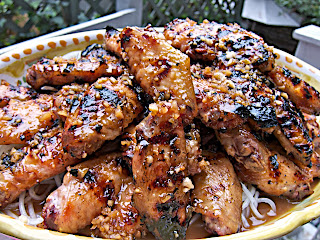
 Spicy Sweet Ginger-Garlic
Spicy Sweet Ginger-Garlic
Chicken WingsWe have a yearly tradition. For Super Bowl Sunday, we invite friends over to our house to eat, have some drinks and watch the game. Until our younger son, Michael, came into our lives, neither of us were much interested in sports.
Attending UCLA during the John Wooden days, when the men's basketball team reigned supreme, I never went to a single game. I didn't care. But Michael did. From the time he was a toddler, he watched Sports Center, baseball, basketball and football.
Like any parent we wanted to find common ground with our son. For us, that meant catching up with a three year old's encyclopedic knowledge of major league sports.
At first a chore, we got into it. We learned to cheer on the Lakers, root for the Dodgers and follow the careers of our favorite quarterbacks (Manning, Brady, Luck, RGIII, Rogers and Kaepernick).

 The cherimoya (pronounced chair-uh-MOY-yuh) is the king of fruit. This is no surprise given that this ancient Incan fruit was originally reserved for royalty.
The cherimoya (pronounced chair-uh-MOY-yuh) is the king of fruit. This is no surprise given that this ancient Incan fruit was originally reserved for royalty. Although New England Clam Chowder (the white creamy version) is probably more popular, Manhattan Clam chowder is equally delicious. More like an Italian soup, this tomato based clam chowder makes a great winter dish.
Although New England Clam Chowder (the white creamy version) is probably more popular, Manhattan Clam chowder is equally delicious. More like an Italian soup, this tomato based clam chowder makes a great winter dish. DAFFODILS
DAFFODILS For all of you out there with cold feet, throbbing headaches, and damp socks.
For all of you out there with cold feet, throbbing headaches, and damp socks.
